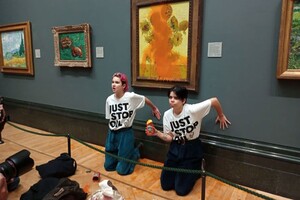Eco-activists Just Stop Oil explained their action with the painting of 1888 as an attempt to draw attention to the government's inaction regarding the cost of living crisis and climate change.

Activists in the field of ecology from the Just Stop Oil group held their most daring protest – threw a can of tomato soup at one of the most famous paintings in the world, “Sunflowers” by Vincent Van Gogh1888. The work is exhibited in the National Gallery in London. A representative of the gallery says that there is minor damage to the frame, but the painting itself is intact, writes The Art Newspaper.
“At around 11 am, two people entered room 43 of the National Gallery. The couple appeared to be glued to the wall adjacent to Van Gogh's Sunflowers. They also threw a red substance that looked like tomato soup onto the painting. The premises were cleared of visitors and the police were called. Now law enforcement officers are working on the spot,” said the press secretary of the gallery.
Currently, both activists have been arrested (apparently, the painting was behind glass)
View this post on Instagram
< p>
Just Stop Oil released a statement saying the group is “demanding that the UK government halt all new oil and gas projects”. The statement added: “Today's action follows two weeks of sustained civil resistance by supporters of Just Stop Oil. The act was a response to the government's inaction on the cost of living crisis and the climate crisis. >In July, Just Stop Oil activists glued themselves to John Constable's famous painting The Hay Wain (1821) at the National Gallery. Other museums in the UK, including the Kelvingrove Art Gallery and Museum in Glasgow, the Manchester Art Gallery and the Royal Academy of Arts in London, have also been targeted, as have institutions in Europe such as the Vatican Museums.
< p>Just Stop Oil is funded by the Climate Emergency Fund, an organization in Los Angeles created by three millionaires in 2019 to support environmental activities.
Related video
Remember, the other day artist Damien Hirst burned 1,000 of his paintings and plans to burn thousands more


